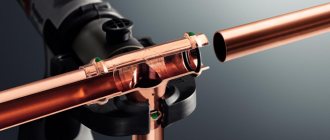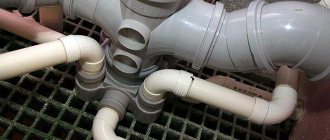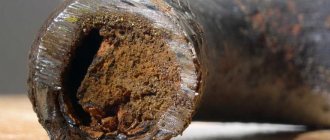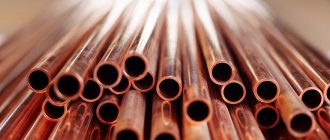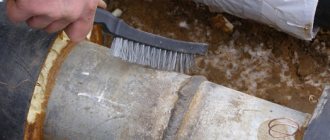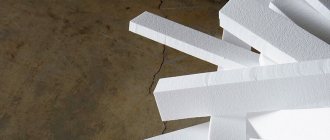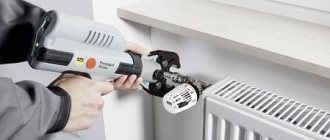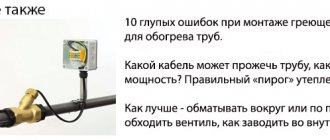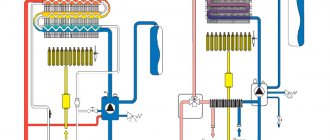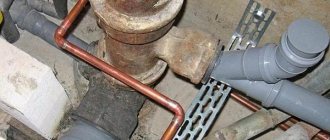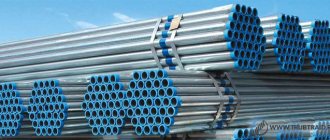Announce the entire list
First, let's remember exactly what types of metal pipes are used in cold and hot water supply systems.
Actually, there are currently only four of them:
- Black steel (water and gas pipes GOST 3262-75);
- Galvanized steel, produced to the same standard;
- Copper;
- Corrugated stainless steel.
It’s interesting: just a few decades ago, cold water supply lines were massively laid with cast iron pipes. However, now they have been almost completely replaced by pressure polyethylene ones.
Standard service life of water pipelines
The length of networks (in single-pipe measurement) in Russia is impressive - it is more than 1 million km! At the same time, about 30% (!) of pipelines are so worn out that they need urgent replacement and repair. Let's take a closer look at the different types of pipelines (water supply, heat supply, sewerage), their condition and problems arising due to their wear and tear and poor quality.
The total length of water supply networks is more than half a million km and approximately 30% of them need replacement and repair. What are the dangers of old steel pipelines overgrown with rust?
It is worth noting that the quality of heating mains is most relevant specifically for Russia, because
We have the highest level of centralized heating supply (up to 80%). Due to the moistening of the materials used during operation, the heat-protective properties of thermal insulation structures are sharply reduced, which leads to heat losses that are 2-3 times higher than the standard ones.
Basic requirements for the technical operation of water supply systems
56.
Before commissioning, after all installation and repair work has been completed, water supply systems are tested using the hydrostatic or manometric method in compliance with the requirements of GOST, GOST and SNiP 3.01.01-85.
In winter, the test is carried out only after the heating system is put into operation.
In cases where it is difficult to carry out hydrostatic tests, a manometric test is carried out. The testing of the system is documented in a document.
Standard service life of water supply pipelines
Steel pipes are characterized by low cost, but the cost of their installation is high.
Some experts claim that the service life of steel pipes is the same, if not longer, than that of houses - KHRUSHCHEVK and BREZHNEVOK - the house will fall apart faster than the cold and hot water risers rust and will not stand! Nowadays, it is not uncommon for housing and communal services to replace perfectly serviceable pipes only in order to “saw off” a lot of money allocated for pipe replacement into their bottomless pockets.
The maximum service life is the time of exposure to constant temperature and pressure on the pipe, which it can withstand without destruction, taking into account the reliability factor. The use of polyethylene pipes is safe and environmentally friendly, i.e.
Service life of steel water supply pipes according to GOST
Obviously, the service life according to SNiP and GOST for such a model is much longer; Each option from the list can be used for water supply, gas pipelines, heating, and not only water, but also steam.
However, their service life will vary.
Black steel for water supply Unfortunately, this option is not particularly durable.
True, its cost is somewhat higher, but at the same time such a pipe: is practically not subject to corrosive destruction; has high resistance to chemically aggressive substances; from an environmental point of view it is absolutely safe; has the highest mechanical strength and heat resistance; the coefficient of thermal expansion of steel is 1.5 times lower than that of copper, and 6 times lower than that of plastics, which allows such pipes to be laid directly in the floors.
Standard service life of steel pipes according to GOST
Several types of metal products are used in heating and water supply systems: black steel pipes - steel of different grades is used in production, but it is not corrosion resistant.
Depending on the size of the alloying additive, steel can be resistant to corrosion under normal conditions, is characterized by increased resistance, which allows use in sea water, for example, and also does not oxidize under the influence of not only moisture, but also high temperature.
Standard service life of hot water pipelines
This is not at all strange, because they are not subject to corrosion, and their service life is many times greater than the “life expectancy” of steel ones.
This is clearly visible in Table 1. Table 1. Construction technologies" No. 4, 2004 Without pipes it is impossible to imagine the life of not only an individual house or enterprise, but also entire districts and cities. Pipes are used to move cold and hot water, to create heating mains, sewerage systems, and for many other purposes.
The length of networks (in single-pipe measurement) in Russia is impressive - it is more than 1 million km! At the same time, about 30% (!) of pipelines are so worn out that they need urgent replacement and repair.
Service life of water pipes
The quality of living in a country house or apartment building largely depends on what kind of water pipes were installed in it.
In this article we will look at several types and characteristics of pipes for home plumbing.
Since then, the metal sewer system has undergone almost no changes. In modern houses and apartments you can see sewer pipes made of the following types of metals: Sewer pipes made of polymers appeared in apartments only at the turn of the 20th and 21st centuries.
Service life of metal water supply pipes: standard and actual service life of the water supply system
No, this is not the Alien's digestive system. Just the insides of an old water supply pipe. How long do metal pipes last for water supply? Today we have to rummage through the regulatory documentation to find the answer to this question and find out why the service life of pipelines is being reduced.
Actually, there are currently only four of them:
- Corrugated stainless steel.
- Black steel (water and gas pipes GOST 3262-75);
- Galvanized steel, produced to the same standard;
- Copper;
It’s interesting: just a few decades ago, cold water supply lines were massively laid with cast iron pipes.
Service life of steel structures
Not long ago, one of our readers inquired about the service life of steel pipes in an apartment. And she really wanted to get a link to some official document.
We actually managed to find something. Not a “law”, of course, but still... This regulatory act establishes the following service life of steel structures: 1.
For central heating pipelines – 30 years.
2. For water supply and sewerage steel pipelines – 15 years. The same galvanized steel pipes will last 2 times longer (30 years).
3. For steel enameled bathtubs and sinks – 15 years.
4. For drainpipes made of galvanized steel – 15 years, for drainpipes made of black steel – 5 years. 5. For roofing: a) from black roofing steel – 15 years.
Source: https://152-zakon.ru/normativnyj-srok-ehkspluatacii-vodovodov-12444/
Black steel
Steel rusts. It rusts especially quickly with prolonged contact with water. That is why the service life of steel risers and connections laid down in the regulatory documents, frankly speaking, is not amazingly long.
Standard service life
The main document establishing the standard service life of utilities in a residential building is VSN (departmental building codes) number 58-88, adopted in 1988. They regulate the timing of maintenance, reconstruction and repair of buildings.
Appendix No. 3 to the document provides the following figures:
Destructive factors
What factors limit the service life of VGP pipes without anti-corrosion coating:
| Image | Description |
| Corrosion. Rusting of the pipe is accelerated by a damaged outer layer of paint, frequent shutdowns of the water supply (in this case, the unpainted inner surface of the pipe is in contact with air with high humidity) and poor ventilation in the bathroom (read: consistently high humidity). The first fistulas appear on longitudinal welds (VGP pipes GOST 3262 are electric welded), on threads where the thickness of the pipe walls is minimal, and in ceilings where the surface of the pipes is not ventilated and (in the case of cold water risers) is continuously wetted by the condensate falling on them. | |
| Overgrowing of pipes with deposits (primarily lime salts) and rust. The rate of overgrowing is directly proportional to the hardness of water in the region: where it erodes sediment on the way to the consumer, the clearance in the water supply decreases much faster. The narrowing of the lumen leads to a drop in water pressure on plumbing fixtures connected to the water supply. | |
| Pipeline diameter. The larger the internal cross-section of the pipe, the longer it maintains acceptable throughput. | |
| Wall thickness. According to GOST 3262, ordinary, reinforced and lightweight pipes are produced. It is clear that those reinforced before the first through fistulas appear will last longer. |
Please note: a steel line overgrown with deposits can often be cleaned with a steel cable or string. Even more effective destruction of deposits is ensured by chemical flushing of the water supply system: an alkaline or acidic environment dissolves lime and iron oxides.
Actual service life
In the author’s memory, the minimum trouble-free service life of a steel cold water supply system in a new building was only 10 years. The house was built and delivered shortly before the collapse of the Union, in conditions of austerity on building materials and the actual inoperability of Soviet norms and standards. Lightweight VGP pipes, purchased for reasons of economy, quickly and en masse began to leak at welded joints and threads.
By the way: despite the same standard service life specified for black steel pipes in cold water and hot water systems, cold water pipes fail much faster. They rust intensively due to the condensation that falls on their surface during the hot season and quickly become overgrown with deposits due to the lack of additives that dissolve lime and rust in drinking water.
The oldest engineering systems made of black steel have been in service for more than half a century.
In addition to the large thickness of the pipe walls, their longevity is facilitated by:
- Low humidity levels;
- No condensate on cold water pipes;
- Periodic painting of risers and liners;
- Low content of mineral salts in water.
Should I choose steel water pipes and what will be their service life?
The design and installation of steel water mains is carried out depending on the material from which they are made.
The service life of a water pipe depends on the quality of the liquid for which the pipeline is used.
An aggressive environment quickly damages the line from the inside if it is not protected with a special coating against chemicals. The service life of steel water pipes depends on the type of structure.
Steel water pipes
Types of structures
The designs are:
- Suture. They are not used in home heating systems, since bending breaks the integrity of the seam and causes it to separate. When producing this type, the seam is not processed from the inside, so leaks occur in such places and replacement will be required. The maximum that can be expected from such a pipe is 3 - 5 years.
- Seamless. More reliable products. The service life of such water pipes can last up to 20 - 30 years, subject to care and timely cleaning of lime deposits and iron oxide. New production technologies make it possible to use special coatings for highways - enamel, ceramics, zinc, which increase the service life and allow you to go without repair or replacement for a long time.
Steel structures are used not only for water, but also for gas and oil pipelines. The duration of use is regulated by GOST standards.
The regulatory documentation also specifies test methods, acceptable welding methods, connection possibilities, technical capabilities of steel pipes - throughput, resistance to pressure and temperatures.
Standard service life of water supply steel pipes according to GOST
There is no state standard for the service life of steel pipe structures.
The average working life of steel mains is about 20 - 25 years, subject to proper operation and professional installation.
The duration of operation of water supply structures depends on the quality of steel, wall thickness, additional insulation against condensation or anti-corrosion coatings.
The characteristics of steel lines may vary depending on the composition of the pumped liquid, its temperature and pressure. The remaining service life of used pipes is determined by an expert commission. Wear calculation is calculated
the ratio of the actual service life to the standard one, the resulting value is multiplied by a factor of 300.
Galvanized water pipes
Galvanized steel pipes are a durable material for the construction of water supply systems. Their technical features are:
- resistance to rust formation inside;
- resistance to increased pressure;
- protection against the negative effects of high temperature;
- absence of harmful compounds that can get into food with water.
Non-ferrous metals do not form rust. Zinc is one such metal. They cover both the inside and outside of the water pipe. The service life of the pipeline depends on the thickness of the applied coating, as well as on the application method. Galvanizing is allowed in several ways:
- Thermal diffusion method. In a closed container, the steel is exposed to zinc vapor at high temperatures. With this treatment, complete adhesion of steel and zinc particles occurs, which makes it possible to obtain a dense, evenly distributed coating over the entire area of the pipe.
- Hot galvanizing. The prepared pipe is immersed in molten zinc at temperatures up to 450 degrees. With this method, non-ferrous metal fills the threaded connections and lays down in an uneven layer - there are sagging and thickening. The method is uneconomical.
- By electrolysis method. The layer of non-ferrous metal is uniform, but does not have strong adhesion to the steel surface, which in the future can provoke chips and cracks in the coating. The porous structure of the zinc layer allows aggressive liquids to penetrate and damage the steel.
Depending on the purpose of galvanized steel structures, a coating method is chosen - more or less reliable.
Galvanized lines have a number of advantages over simple steel pipes during operation:
- thermal expansion deforms structures less;
- resistant to mechanical damage;
- a smooth internal surface increases the throughput of the pipeline, which reduces the risk of the pipe section becoming overgrown with foreign deposits - lime, sand, dirt;
- withstand pressure up to 1.6 MPa;
- resistance to iron oxide damage for 20 years or more.
It is not recommended to use galvanized elements when organizing wells for home water supply. Contact with the ground changes the chemical parameters of water, and corrosion may form at the joints due to damage to the zinc coating during welding.
The safest and longest lasting galvanized lines can be used to deliver cold water with a high pH - from 7.5 to 8.5. This is rare for a city water supply, since not everywhere there are installations for high-quality wastewater treatment and reducing its acidity.
Hot water increases the rate of corrosion formation by 5 times, and temperature fluctuations inside the pipe cause the destruction of the protective coating.
Connections between galvanized and copper pipes also reduce the quality of the coating, since copper ions act aggressively and reduce the life of the pipeline.
According to regulatory data, galvanized steel structures:
- should not have cracks or swelling;
- may have traces of stripping if the protective coating layer is not reduced to the maximum permissible values;
- the end parts should not have delamination or nicks exceeding 0.5 mm;
- The cut is made at a right angle, the bevel is no more than 2 degrees.
The sections may not have a zinc coating, as they are intended for welding. Coupling connections are covered with a full protective layer with a thickness of at least 30 microns.
Ferrous metals for plumbing
Compared to materials that have a variety of protective coatings, water supply structures made of ferrous metals are a budget-friendly and not the most reliable option for arranging a water supply system.
Carbon steel lines have the following disadvantages during operation:
- They are susceptible to condensation, so additional insulation of the outer layer is required. Excess steam promotes corrosion.
- Reduction in internal diameter due to sediment in areas where the water contains salt impurities. Deposits on the internal walls reduce the performance of water pipes made from steel pipes.
- Makes installation work difficult.
- They have an unaesthetic appearance.
- The service life declared by the manufacturer does not correspond to the actual one, and the pipes have to be replaced faster. It is impossible to predict how long the structure will last.
The advantages of steel water supply are:
- low cost;
- high resistance to temperatures and deformations;
- resistance to mechanical damage.
According to GOST, pipe lines must operate for a maximum of 20 years, but much depends on the quality of installation work and the chemical composition of the transported liquid.
Is it worth choosing steel pipes for water supply?
In an apartment building, the pipeline is installed with the expectation of 30 years of operation. Steel can withstand this period quite well.
Blockages caused by the accumulation of sand, lime, and corrosion can reduce the performance of the pipe.
In order for steel structures to last longer, they have to be professionally cleaned from time to time, which requires additional financial costs.
The use of metal pipes from the cheap segment in apartment and private buildings is unjustified, since replacing a pipeline is a costly process and involves turning off water for several days.
Cink Steel
Thanks to its anti-corrosion coating, galvanizing should be more durable than black steel. How much?
Standard service life
We can find data about him in the same VSN 58-88:
Destructive factors
How and why can a galvanized metal pipe for water supply fail?
While working as a plumber, the author observed the only scenario for the appearance of fistulas on galvanized water pipes: they occurred at a welded joint. Strictly speaking, galvanized pipes cannot be welded “at all”: in the area of the seam the zinc burns out completely. You see, it evaporates already at 900 degrees, and steel melts at 1400-1500.
As a result, the owner of a galvanized water supply system mounted on welded joints receives a pipeline made of corrosion-resistant (albeit in some places) material, but at twice the price.
How to properly install galvanization with your own hands to ensure maximum service life of the water supply system?
Here are the instructions that plumbing equipment installers used in the 50-60s of the last century:
- All connections are made only and exclusively on threads (cut by hand or on a lathe) using cast iron threaded fittings;
- The connections are sealed with plumbing flax and the windings are impregnated with red lead.
Do galvanized water supply pipes become overgrown? Deposits and rust do not linger on their walls, but the formation of a water-impenetrable plug is still possible under certain circumstances. It goes like this:
- Debris accumulates in the water supply (usually cold) - sand, welding scale and rust flakes. A blockage is formed if the water supply taps are always opened only partially, and the speed of the water flow does not allow it to carry debris into the mixer and further into the sewer;
- Over time, the accumulation of debris is cemented with lime and iron oxides, gradually turning into a material with the strength of stone.
Actual service life
The author of the article must repent to the reader: he cannot name either the minimum or maximum service life of galvanized water supply. The fact is that he has never encountered a galvanized pipe that needed replacement due to natural wear and tear.
The lines and risers, which were opened after 50-70 years of operation, were invariably in impeccable condition and were no different from new ones.
Service life of steel heating pipes in a private house
The quality of living in a country house or apartment building largely depends on what kind of water pipes were installed in it. In this article we will look at several types and characteristics of pipes for home plumbing.
Modern pipe manufacturers use a range of structural materials in the manufacture of their products. However, currently, only plastic or metal pipes are used in water supply systems.
The first metal water pipes appeared in the homes of wealthy citizens 3 centuries ago. Since then, the metal sewer system has undergone almost no changes.
In modern houses and apartments you can see sewer pipes made of the following types of metals:
- High-carbon, structural, unalloyed steel without corrosion protection, otherwise known as “black.”
- Copper of a high purity level with a minimum amount of impurities of antimony, lead and arsenic (less than 0.001 percent).
- High-carbon, structural steel with a zinc-based anti-corrosion coating, otherwise known as galvanized steel.
- Steel alloyed with chromium, or “stainless steel”.
Sewage pipes made of polymers appeared in apartments only at the turn of the 20th and 21st centuries. It was at this time that an industrial method for the polymerization of organic substances was created, with the help of which the following types of structural polymers were created:
- Polyethylene is the purest type of plastic, suitable for the construction of drinking water pipelines.
- Polypropylene is a plastic with high heat resistance and high ring rigidity.
- Polyvinyl chloride is a material with excellent structural rigidity and an excellent ratio between wall thickness and product diameter, guaranteeing a high level of throughput.
In addition to the above-mentioned types of sewer pipes, water supply systems made of metal-plastic have now appeared, which are a structural material that includes layers of metal (aluminum foil) and plastic (polypropylene, polyethylene).
The properties of fittings and water pipes depend on a number of factors, including parameters of the transported medium, characteristics of the external environment, and others. Of course, the structural materials of the pipes have the greatest influence on the properties of the pipeline system. After all, the ability of pipelines to resist internal and external influences depends only on them.
In this article we will look at the characteristics of all materials used for the production of pipes and touch on their positive and negative qualities.
Metal pipes can be steel, copper, galvanized and stainless steel.
Despite the differences between these types of metal, they all have a common set of advantages, including:
- High level of heat resistance. Steel and copper pipes are capable of working in hot and cold pipelines. In addition, these metals can withstand very high temperature loads compared to polymer products (up to 300 degrees Celsius). Therefore, pipes made from such materials can be used not only for drinking and technical water pipes, but also for the home heating system.
- High level of ring stiffness. Metal water pipes can withstand short-term loads equal to 250 MPa, which is significantly higher than that of plastic elements. This suggests that the throughput of metal structures is an order of magnitude better than that of similar polymer products.
- Excellent maintainability. Any metal pipe can be repaired without completely dismantling the plumbing system. Copper pipes are repaired by soldering, and steel pipes by welding.
Metal water pipes have one common drawback - they all have a large mass.
Steel and copper structures generally weigh up to 10 times more than those made of plastic. In addition, installing steel systems will cost more time and money than installing polymer pipes. Water pipes made of steel are mounted either on not the most reliable threaded connections, or on very reliable welding. Copper pipes are installed using compression couplings or soldering.
Copper pipes differ from their metal “brothers” in that they are almost not subject to corrosion, due to which they last an incredibly long time. In the absence of serious breakdowns, a copper plumbing system can last for several centuries. However, this metal is quite expensive and pipes made from it are several times more expensive than steel ones.
The exact characteristics of steel water pipes depend on what type of steel it was made from. For example, non-galvanized water pipes are characterized by their low cost design and the widespread use of this substance, but on the other hand, their service life is quite low.
Steel pipes coated with a layer of galvanization do not have this disadvantage, however, they are much less suitable for repair and have several restrictions on the type of installation; they can only be assembled using threads. “Stainless steel” has almost no disadvantages. It is relatively inexpensive and easy to repair.
But there is a minus here too. It involves the incredibly labor-intensive process of installing stainless steel plumbing. This is due to a number of difficulties during welding of such pipes. Therefore, you will have to spend a lot of money on the services of a specialist welder.
Having examined the variety of different designs made from these materials, it is easy to understand that such pipelines have many advantages, including the following qualities:
- Complete independence from pumped substances. Plastic pipes not only do not change their properties under the influence of liquid passing through them, but also do not affect their chemical composition, which is especially important when constructing drinking water pipelines.
- Good level of ring stiffness. A pipeline made of polymer materials can withstand a pressure of 5 MPa. Of course, this is not much compared to systems made of copper and steel, but in most cases the pressure in domestic water supply systems does not exceed half of this figure, so the ring rigidity of polymer pipelines will be quite sufficient even to provide water to an apartment building.
- Long service life. With proper installation and careful use, a polymer pipe can last 100 years, which is several times longer than that of a non-galvanized steel pipe.
- The installation process is very simple, most operations can be completed without the help of specialists.
The negative properties of polymer materials common to all types include:
- High level of flammability. During a fire, plastic pipes not only burn, but also release a lot of toxic substances into the environment.
- Poor structural rigidity. Polymer pipes cannot resist either transverse or longitudinal deformations.
- Susceptibility to mechanical damage. The pipe can be damaged by any sharp or heavy object.
Water pipes and fittings made of polypropylene have the following set of advantages:
- The ability to withstand the high temperature of the transported substance (up to 95 degrees Celsius), so polypropylene pipes can be used not only to transmit cold, but also hot water.
- Very low cost. This applies both to the pipes themselves and to their installation. Polypropylene water supply will cost the buyer less than all others.
The disadvantages of this material include the difficult process of installing dismountable connections in pressure systems. The method of installing polypropylene pipes is based on either gluing joints or soldering. To arrange a dismountable unit, you can use a special fitting, which, in addition to a polypropylene body, also has a metal fitting.
The main advantage of polyethylene pipes is the high level of plasticity. Only these pipes can freeze along their entire length in winter and thaw in summer without losing their tightness.
A high ductility index ensures good seismic stability of the system.
Polyethylene water pipes are not afraid of any movements or shocks in the ground.
The disadvantages of this material include low heat resistance; a polyethylene pipe can only pump cold water, the temperature of which does not exceed 40 degrees Celsius.
Products made from polyvinyl chloride are almost never used for pumping water. This material is quite fragile and is mainly used in sewerage systems. However, this material can often be found in drainage systems for fire extinguishing systems, because it is the most heat-resistant type of polymer and can withstand temperatures up to 400 degrees Celsius.
In terms of their positive and negative characteristics, these products are similar to conventional polymer products. For example, the service life of a metal-plastic system does not exceed 80 years, just like a polypropylene water supply system.
Installation of these tubes is also easy because they are installed on special fittings.
This material, which is a symbiosis of plastic and metal, differs from conventional polymer pipes in a slightly different installation technology. In addition, metal-plastic pipes are produced only in certain sizes, and their diameter does not exceed 63 millimeters.
The range of metal pipes is determined by special regulatory documents. Based on the same principle, standards have been established for the production of pipes from polymers. GOST describes all geometric parameters. According to it, the minimum diameter of a steel pipe is 6 millimeters, and the maximum is 150 millimeters. For copper pipes, this figure varies from 6 to 267 millimeters, and the wall thickness can vary from 0.5 to 3 millimeters.
Polypropylene and polyethylene water pipes can be produced in 34 standard sizes. The smallest size of a polymer pipe is 1 centimeter, and the largest is 160 centimeters. For plumbing systems, it is optimal to use pipes with a cross-sectional diameter of up to 16 centimeters, that is, a total of 15 standard sizes. Metal-plastic pipes are produced in 11 options from 14 to 110 millimeters.
At the same time, fittings for pipes are produced with a diameter of no more than 63 millimeters, so the actual range of metal-plastic pipes is limited to 8 standard sizes.
How long do metal pipes last for water supply? Today we have to rummage through the regulatory documentation to find the answer to this question and find out why the service life of pipelines is being reduced. Let's get started.
First, let's remember exactly what types of metal pipes are used in cold and hot water supply systems.
Actually, there are currently only four of them:
- Black steel (water and gas pipes GOST 3262-75);
- Galvanized steel, produced to the same standard;
- Copper;
- Corrugated stainless steel.
It’s interesting: just a few decades ago, cold water supply lines were massively laid with cast iron pipes. However, now they have been almost completely replaced by pressure polyethylene ones.
Steel rusts. It rusts especially quickly with prolonged contact with water. That is why the service life of steel risers and connections laid down in the regulatory documents, frankly speaking, is not amazingly long.
The main document establishing the standard service life of utilities in a residential building is VSN (departmental building codes) number 58-88, adopted in 1988. They regulate the timing of maintenance, reconstruction and repair of buildings.
Appendix No. 3 to the document provides the following figures:
What factors limit the service life of VGP pipes without anti-corrosion coating:
The first fistulas appear on longitudinal welds (VGP pipes GOST 3262 are electric welded), on threads where the thickness of the pipe walls is minimal, and in ceilings where the surface of the pipes is not ventilated and (in the case of cold water risers) is continuously wetted by the condensate falling on them.
The rate of overgrowing is directly proportional to the hardness of water in the region: where it erodes sediment on the way to the consumer, the clearance in the water supply decreases much faster. The narrowing of the lumen leads to a drop in water pressure on plumbing fixtures connected to the water supply.
It is clear that those reinforced before the first through fistulas appear will last longer.
Please note: a steel line overgrown with deposits can often be cleaned with a steel cable or string. Even more effective destruction of deposits is ensured by chemical flushing of the water supply system: an alkaline or acidic environment dissolves lime and iron oxides.
In the author’s memory, the minimum trouble-free service life of a steel cold water supply system in a new building was only 10 years. The house was built and delivered shortly before the collapse of the Union, in conditions of austerity on building materials and the actual inoperability of Soviet norms and standards. Lightweight VGP pipes, purchased for reasons of economy, quickly and en masse began to leak at welded joints and threads.
By the way: despite the same standard service life specified for black steel pipes in cold water and hot water systems, cold water pipes fail much faster. They rust intensively due to the condensation that falls on their surface during the hot season and quickly become overgrown with deposits due to the lack of additives that dissolve lime and rust in drinking water.
The oldest engineering systems made of black steel have been in service for more than half a century.
In addition to the large thickness of the pipe walls, their longevity is facilitated by:
- Low humidity levels;
- No condensate on cold water pipes;
- Periodic painting of risers and liners;
- Low content of mineral salts in water.
Thanks to its anti-corrosion coating, galvanizing should be more durable than black steel. How much?
We can find data about him in the same VSN 58-88:
How and why can a galvanized metal pipe for water supply fail?
While working as a plumber, the author observed the only scenario for the appearance of fistulas on galvanized water pipes: they occurred at a welded joint. Strictly speaking, galvanized pipes cannot be welded “at all”: in the area of the seam the zinc burns out completely. You see, it evaporates already at 900 degrees, and steel melts at 1400-1500.
As a result, the owner of a galvanized water supply system mounted on welded joints receives a pipeline made of corrosion-resistant (albeit in some places) material, but at twice the price.
How to properly install galvanization with your own hands to ensure maximum service life of the water supply system?
Here are the instructions that plumbing equipment installers used in the 50-60s of the last century:
- All connections are made only and exclusively on threads (cut by hand or on a lathe) using cast iron threaded fittings;
- The connections are sealed with plumbing flax and the windings are impregnated with red lead.
Do galvanized water supply pipes become overgrown? Deposits and rust do not linger on their walls, but the formation of a water-impenetrable plug is still possible under certain circumstances. It goes like this:
- Debris accumulates in the water supply (usually cold) - sand, welding scale and rust flakes. A blockage is formed if the water supply taps are always opened only partially, and the speed of the water flow does not allow it to carry debris into the mixer and further into the sewer;
- Over time, the accumulation of debris is cemented with lime and iron oxides, gradually turning into a material with the strength of stone.
The author of the article must repent to the reader: he cannot name either the minimum or maximum service life of galvanized water supply. The fact is that he has never encountered a galvanized pipe that needed replacement due to natural wear and tear.
The lines and risers, which were opened after 50-70 years of operation, were invariably in impeccable condition and were no different from new ones.
The next metal on our list is copper.
How long can these metal hot water pipes last? There are no regulatory documents establishing specific service periods. Manufacturers promise a vague “50+” years.
- The oldest copper water pipes have been in service for more than a century and are still in perfect condition;
- Copper does not degrade over time, is not subject to corrosion and is only afraid of significant mechanical stress: the metal is very plastic, and the pipe walls are only about a millimeter thick.
As they say in the hero city of Odessa, “there are some”:
- The service life of copper plumbing may be reduced if press fittings with rubber O-rings are used instead of soldering when installing it. Over 20-30 years, rubber loses its elasticity (primarily in hot water) and is capable of leaking;
- Banal erosion can lead to destruction of the walls of copper pipes. At high flow rates, sand and other suspended matter rapidly destroy soft metal;
Note: the problem is solved by installing coarse filters and limiting the water flow speed to 2 m/s.
- Theoretically, water hammer and freezing of water in it can break a copper water supply. However, the water hammer must be truly extreme (the destructive pressure for copper pipes is 200 - 240 atmospheres), and defrosting must be repeated at least 5-6 times: the plasticity of copper allows it to withstand a slight change in diameter or length without destruction.
How long will corrugated stainless steel last in a water supply?
According to one of the leading manufacturers, the Lavita company - indefinitely. Lavita explicitly states that its products have an unlimited service life.
However: silicone seals in press fittings will still have to be changed after 30 years. This work is not difficult: the fitting can be disassembled to replace the seal with a pair of adjustable wrenches in 30-60 seconds.
What is the actual service life of stainless steel in water supply cannot yet be said simply because of the limited time of its operation.
The only thing that can cause damage to a stainless water supply is rough mechanical impact. Thin (only 0.3 mm) walls are easily crushed by a strong impact.
But you don’t have to be afraid of the notorious water hammer and defrosting:
- The combination of a tensile strength of 210 atmospheres (according to the Lavita company) in combination with corrugated walls that act as a damper will allow the water supply system to withstand any short-term pressure surge;
- When water freezes, corrugation will allow the pipe to lengthen and accommodate the volume of ice that has increased during crystallization without destruction.
We hope that we were able to satisfy the curiosity of the reader. The video in this article will help you learn more about how long water supply pipes - metal and plastic - can last. Good luck!
It is very difficult to name those areas in which steel pipes are not used. They are used in oil pipelines, heating mains, main water pipelines, heating systems and many others. Many people are interested in how long a steel pipe can last. Their service life depends greatly on operating conditions.
How long can steel heating pipes last?
A heating system that uses steel pipes has always been considered durable and reliable, capable of withstanding fairly heavy loads. The service life of steel heating pipes is thirty years. But why do some owners of newly built houses refuse steel pipes and prefer to make heating from plastic? The whole point is that the pipes are chosen incorrectly. There are two types of steel pipes:
— suture
. This is the cheapest type of steel pipe. The choice of this type of pipe for heating is doomed to failure in advance, since its service life is only a few years and they will not live up to thirty years. This is because when installing a heating system, it is very difficult to bend such a pipe and the seam simply bursts at the bend. Also, the inside of the seam cannot be properly processed; a leak may appear and the pipe will need to be replaced. Therefore, it is not suitable for heating systems;
— seamless
. Such pipes are much more reliable. For individual heating, such pipes with a diameter of 25 mm are recommended; when tested, they can withstand loads of up to 20 atmospheres. Therefore, for at least twenty years, such pipes will last without problems.
Remember that previously only steel pipes were installed for the heating system. And often, when installing autonomous heating and replacing steel pipes with plastic ones, it turned out that they could serve for a long time, despite the fact that they were installed twenty years ago.
How long can steel water pipes last?
The service life of steel water pipes and sewer pipes made of the same metal is fifteen years. The same galvanized steel pipes can last for thirty years. During the first five years of operation, the inner surface of the water supply pipes becomes overgrown, and wet condensation appears on the surface, not to mention the fact that they withstand high dynamic loads. And galvanized steel pipes are coated with an anti-corrosion coating, so they can last much longer.
Advantages and disadvantages of steel pipes
Advantages:
- low cost, however, this is compensated by the high cost of installation work;
— with increasing temperatures there is slight deformation;
— corrosion. However, to delay it, a zinc coating is used, which is found on galvanized pipes, which can last the longest;
— to work with pipes, welding is required;
— with a sharp increase in pressure, the pipe may rupture.
One of the important characteristics of the product is, among other things, the period of operation. Any material wears out over time, but this time can be very different and depends on the load, on additional factors and, of course, on the quality of the product itself. The standard service life of steel water pipes largely determines their purpose.
Several types of metal products are used in heating and water supply systems:
- black steel pipes - steel of different grades is used in production, but it is not corrosion resistant. Such rolled metal products require additional protection - painting, for example;
- galvanized steel pipes - products are coated with a layer of zinc. The latter forms a galvanic couple with iron and is destroyed by an electrochemical reaction, protecting the steel from corrosion. Obviously, the service life according to SNiP and GOST for such a model is much longer;
- stainless steel – alloys with the addition of nickel and chromium. Depending on the size of the alloying additive, steel can be resistant to corrosion under normal conditions, is characterized by increased resistance, which allows use in sea water, for example, and also does not oxidize under the influence of not only moisture, but also high temperature. The product does not need protection, however, its cost is noticeably higher;
- copper - rare, but used in domestic conditions. They are distinguished not only by their resistance to corrosion, but also by their disinfecting properties.
Each option from the list can be used for water supply, gas pipelines, heating, and not only water, but also steam. However, their service life will vary.
Alas, this option is not particularly durable. Even with the most careful painting and care, they will rust over time. The fact is that after the construction of communications, individual fragments turn out to be inaccessible, and it turns out to be impossible to update the paint, for example.
In addition, black steel loses its smoothness quite quickly. And this leads to the fact that the water-gas or heating pipe “overgrows” quite quickly: first very small debris and salt deposits are retained on the unsmooth surface, and then increasingly larger particles of rust, fibers, and lime deposits. The rate of sediment accumulation is directly proportional to water hardness.
Constant contact with moisture - in the bathroom, for example, in the toilet, leads to faster destruction of the material, which is reflected in SNiP standards. Here the weak link is often the seams: the first fistulas appear precisely on the welds and threads, where the wall thickness decreases.
Standard operating times are:
- the service life of steel water pipes - riser or liner - is 15 years;
- the heating system assembled from gas steel pipes is suitable for use for 10 years;
- heated towel rails in the bathroom can “work” for 15 years;
- According to GOST, the standard service life of a gas pipeline made of steel pipes is 30 years.
In fact, destructive factors of various kinds significantly reduce the operating time. For example, a pipeline with cold water wears out much faster than with hot water, since it rusts faster: condensation appears in the warm season. And the pipeline overgrows faster, since hot water contains special additives that prevent this.
This material is much more resistant to corrosion, which significantly extends the standard time. The most significant destructive factor here is only the welded connection, if for some unknown reason the installation is carried out by welding. The photo shows water and gas steel pipes.
In fact, this installation method is prohibited: the zinc completely burns out during welding, and accordingly, the seams remain completely defenseless against rust.
Galvanized steel products overgrow much more slowly. Firstly, the smoothness of the wall is much higher, and secondly, there is much less “garbage” itself - particles of rust, scale, sand. But if the taps in the plumbing system are not fully opened and there is not a sufficiently dense flow of water, scale and sand can accumulate.
The service life of the product according to GOST is as follows:
- risers and connections in cold water supply systems are in use for 30 years;
- the service life of steel heating pipes in a house with a closed system is 20 years;
- an open heating system will last 30 years.
It is allowed to construct a gas pipeline from galvanized pipes. But there is still a nuance: unlike plumbing systems, the gas pipeline must be one-piece, which requires welding. And the connection destroys zinc at the junction. On the other hand, gas pipelines, like water pipelines, are coated with polymer paint, which prevents corrosion.
In fact, galvanized steel pipes for both water supply and heating last 50–70 years.
Copper
The next metal on our list is copper.
How long can these metal hot water pipes last? There are no regulatory documents establishing specific service periods. Manufacturers promise a vague “50+” years.
In practice:
- The oldest copper water pipes have been in service for more than a century and are still in perfect condition;
- Copper does not degrade over time, is not subject to corrosion and is only afraid of significant mechanical stress: the metal is very plastic, and the pipe walls are only about a millimeter thick.
Destructive factors
As they say in the hero city of Odessa, “there are some”:
- The service life of copper plumbing may be reduced if press fittings with rubber O-rings are used instead of soldering when installing it. Over 20-30 years, rubber loses its elasticity (primarily in hot water) and is capable of leaking;
- Banal erosion can lead to destruction of the walls of copper pipes. At high flow rates, sand and other suspended matter rapidly destroy soft metal;
Note: the problem is solved by installing coarse filters and limiting the water flow speed to 2 m/s.
- Theoretically, water hammer and freezing of water in it can break a copper water supply. However, the water hammer must be truly extreme (the destructive pressure for copper pipes is 200 - 240 atmospheres), and defrosting must be repeated at least 5-6 times: the plasticity of copper allows it to withstand a slight change in diameter or length without destruction.
Corrugated stainless steel pipe
How long will corrugated stainless steel last in a water supply?
According to one of the leading manufacturers, the Lavita company - indefinitely. Lavita explicitly states that its products have an unlimited service life.
However: silicone seals in press fittings will still have to be changed after 30 years. This work is not difficult: the fitting can be disassembled to replace the seal with a pair of adjustable wrenches in 30-60 seconds.
What is the actual service life of stainless steel in water supply cannot yet be said simply because of the limited time of its operation.
Destructive factors
The only thing that can cause damage to a stainless water supply is rough mechanical impact. Thin (only 0.3 mm) walls are easily crushed by a strong impact.
But you don’t have to be afraid of the notorious water hammer and defrosting:
- The combination of a tensile strength of 210 atmospheres (according to the Lavita company) in combination with corrugated walls that act as a damper will allow the water supply system to withstand any short-term pressure surge;
- When water freezes, corrugation will allow the pipe to lengthen and accommodate the volume of ice that has increased during crystallization without destruction.
Metal water pipes
The first metal water pipes appeared in the homes of wealthy citizens 3 centuries ago. Since then, the metal sewer system has undergone almost no changes.
In modern houses and apartments you can see sewer pipes made of the following types of metals:
- High-carbon, structural, unalloyed steel without corrosion protection, otherwise known as “black.”
- Copper of a high purity level with a minimum amount of impurities of antimony, lead and arsenic (less than 0.001 percent).
- High-carbon, structural steel with a zinc-based anti-corrosion coating, otherwise known as galvanized steel.
- Steel alloyed with chromium, or “stainless steel”.
Plastic water pipes
Sewage pipes made of polymers appeared in apartments only at the turn of the 20th and 21st centuries. It was at this time that an industrial method for the polymerization of organic substances was created, with the help of which the following types of structural polymers were created:
- Polyethylene is the purest type of plastic, suitable for the construction of drinking water pipelines.
- Polypropylene is a plastic with high heat resistance and high ring rigidity.
- Polyvinyl chloride is a material with excellent structural rigidity and an excellent ratio between wall thickness and product diameter, guaranteeing a high level of throughput.
In addition to the above-mentioned types of sewer pipes, water supply systems made of metal-plastic have now appeared, which are a structural material that includes layers of metal (aluminum foil) and plastic (polypropylene, polyethylene).
The properties of fittings and water pipes depend on a number of factors, including parameters of the transported medium, characteristics of the external environment, and others. Of course, the structural materials of the pipes have the greatest influence on the properties of the pipeline system. After all, the ability of pipelines to resist internal and external influences depends only on them.
In this article we will look at the characteristics of all materials used for the production of pipes and touch on their positive and negative qualities.
Plastic pipes
Plastic pipes (polymer) used for the installation of internal water supply systems do not contradict established construction standards (SNiP). They can be used when laying external networks in a channel manner (in the ground) and on the surface, with additional thermal insulation.
Plastic pipes
The service life is practically unlimited. The polymer used completely eliminates the possibility of corrosion (exception: threaded fittings) and reduction of the internal cross-section due to contamination with insoluble compounds. The main reason for the failure of water pipe systems in individual and apartment buildings is poor-quality installation of hot water supply systems (open, closed).
The use of material intended exclusively for cold water supply in hot water supply systems leads to natural destruction of hot water supply lines.
The service life of water pipes in an apartment building or in individual individual buildings depends on the material of the pipes, the quality of installation of communications and the quality of the water used.
Characteristics of metal structures
Metal pipes can be steel, copper, galvanized and stainless steel.
Despite the differences between these types of metal, they all have a common set of advantages, including:
- High level of heat resistance. Steel and copper pipes are capable of working in hot and cold pipelines. In addition, these metals can withstand very high temperature loads compared to polymer products (up to 300 degrees Celsius). Therefore, pipes made from such materials can be used not only for drinking and technical water pipes, but also for the home heating system.
- High level of ring stiffness. Metal water pipes can withstand short-term loads equal to 250 MPa, which is significantly higher than that of plastic elements. This suggests that the throughput of metal structures is an order of magnitude better than that of similar polymer products.
- Excellent maintainability. Any metal pipe can be repaired without completely dismantling the plumbing system. Copper pipes are repaired by soldering, and steel pipes by welding.
Metal water pipes have one common drawback - they all have a large mass.
Steel and copper structures generally weigh up to 10 times more than those made of plastic. In addition, installing steel systems will cost more time and money than installing polymer pipes. Water pipes made of steel are mounted either on not the most reliable threaded connections, or on very reliable welding. Copper pipes are installed using compression couplings or soldering.
Copper pipes differ from their metal “brothers” in that they are almost not subject to corrosion, due to which they last an incredibly long time. In the absence of serious breakdowns, a copper plumbing system can last for several centuries. However, this metal is quite expensive and pipes made from it are several times more expensive than steel ones.
Features of steel pipeline communications
Installation of heating pipes when connecting shut-off/control valves or steel pipelines using a flange connection, where 1 – steel pipe; 3 – steel flange according to GOST 12820-80 with a groove of internal diameter (2); 4 – collar bushing; 5 – gasket; 6 and 7 – fastening elements; 8 – coupling welded into a socket to a pipeline made of polymer material and a collar bushing.
Steel pipes can easily withstand hydraulic loads, and this does not affect their durability and, accordingly, does not shorten their service life. They have good thermal conductivity, and the low coefficient of expansion of the material when temperatures change allows it to be hidden in the wall. They are also perfect for creating radiant forms of water heating.
However, the disadvantages of metal steel communications are no less than the advantages. Of course, they are heavy and bulky, which makes them not so convenient to use. Installation of pipes is not possible without gas welding, which significantly increases its cost. On average, steel pipes last more than 20 years in real life.
They are operated in terrible conditions underground or in multi-storey buildings as various utility lines at a coolant temperature that is close to boiling and an internal pressure of more than 6 atm. And with water hammer it reaches 12-15 atmospheres. It is in such conditions that they are actually used, in a mode in which no metal-plastic or plastic pipe could withstand even 15 minutes of operation. This is the main advantage of metal pipes.
In an ordinary city multi-storey building, steel pipes serve either openly or plastered in brick walls. In conditions in which the internal temperature is 6-7 atm, and the water temperature reaches 90 degrees, only pipes made of steel can work.
Due to their mechanical strength and low coefficient of thermal expansion, types of metal pipes currently have no competitors in the water supply and heat supply systems in urban multi-story buildings. But no one wants to work with such pipes, since they are straight (sometimes reaching 12 meters), heavy and difficult to transport. The most unpleasant thing when working with them is that they are installed using gas welding.
Properties of steel pipes
The exact characteristics of steel water pipes depend on what type of steel it was made from. For example, non-galvanized water pipes are characterized by their low cost design and the widespread use of this substance, but on the other hand, their service life is quite low.
Steel pipes coated with a layer of galvanization do not have this disadvantage, however, they are much less suitable for repair and have several restrictions on the type of installation; they can only be assembled using threads. “Stainless steel” has almost no disadvantages. It is relatively inexpensive and easy to repair.
But there is a minus here too. It involves the incredibly labor-intensive process of installing stainless steel plumbing. This is due to a number of difficulties during welding of such pipes. Therefore, you will have to spend a lot of money on the services of a specialist welder.
Characteristics of polymer pipes
Having examined the variety of different designs made from these materials, it is easy to understand that such pipelines have many advantages, including the following qualities:
- Complete independence from pumped substances. Plastic pipes not only do not change their properties under the influence of liquid passing through them, but also do not affect their chemical composition, which is especially important when constructing drinking water pipelines.
- Good level of ring stiffness. A pipeline made of polymer materials can withstand a pressure of 5 MPa. Of course, this is not much compared to systems made of copper and steel, but in most cases the pressure in domestic water supply systems does not exceed half of this figure, so the ring rigidity of polymer pipelines will be quite sufficient even to provide water to an apartment building.
- Long service life. With proper installation and careful use, a polymer pipe can last 100 years, which is several times longer than that of a non-galvanized steel pipe.
- The installation process is very simple, most operations can be completed without the help of specialists.
The negative properties of polymer materials common to all types include:
- High level of flammability. During a fire, plastic pipes not only burn, but also release a lot of toxic substances into the environment.
- Poor structural rigidity. Polymer pipes cannot resist either transverse or longitudinal deformations.
- Susceptibility to mechanical damage. The pipe can be damaged by any sharp or heavy object.
A few more benefits
It is worth mentioning the lifespan of steel pipes in Stalin-built houses, where they are used in the heating system at a temperature not exceeding 50-60 degrees. Heating systems that are equipped with cast iron radiators can easily last for more than a century. Although they can’t even do it, they still serve. There are cases when such heating systems were built at the end of the 19th century and functioned perfectly until the mid-80s of the 20th century.
It is worth noting another good property of steel. It is difficult to overestimate - this is the lowest coefficient of thermal expansion among other pipes. So, for example, for copper it is 2 times greater, and for plastic it is 15-20 times greater. In simple terms, this is the stability of their sizes.
So, no other pipes should be hidden in the walls or floor, since they increase or decrease in size when the temperature changes (this is especially important if heating is being considered). And this already leads to a violation of the integrity of the coating in which they are mounted. Therefore, when using non-metallic pipes, compensating structures such as, for example, soft thermal insulation are used.
A steel pipe, like many metal pipes, is best suited for the construction of radiant (not to be confused with radiant) water heating systems. If we talk about disadvantages, the most important ones include a high level of corrosion, as well as damage of various types. All steel pipes used in heating rust very quickly and become clogged with various deposits. The best way to protect is to use galvanizing technology and laying pipes of larger diameter.
Perhaps the only and main disadvantage of using galvanizing is the impossibility of using antifreeze in this system, on which operation, that is, service life, depends. If we consider in more detail, zinc coating increases their resistance to corrosion, which can cause their service to deteriorate. This helps to extend the “life” and service life of metal structures by approximately several years.
Properties of polypropylene products
Water pipes and fittings made of polypropylene have the following set of advantages:
- The ability to withstand the high temperature of the transported substance (up to 95 degrees Celsius), so polypropylene pipes can be used not only to transmit cold, but also hot water.
- Very low cost. This applies both to the pipes themselves and to their installation. Polypropylene water supply will cost the buyer less than all others.
The disadvantages of this material include the difficult process of installing dismountable connections in pressure systems. The method of installing polypropylene pipes is based on either gluing joints or soldering. To arrange a dismountable unit, you can use a special fitting, which, in addition to a polypropylene body, also has a metal fitting.
Timing for replacing risers in an apartment building
You need to write an application to replace the risers, indicating a good reason and attaching at least 2 photographs of communications.
The document is executed in two copies, one remains in the housing office, and the second with a mark of acceptance must be taken with you.
To accept and consider the application, it is important that the homeowner be a bona fide utility payer. The following scenarios are possible:
- The repair team quickly responds and replaces the emergency riser. The owner of the living space, in turn, provides access to the bathroom for unhindered repair work.
- The management company refuses to replace the vertical pipeline, citing the fact that the pipeline is located on the owner’s premises and the owner of the apartment is responsible for it. In this case, you receive a written response with a refusal.
Time frame for replacing risers in an apartment building SNP
Pipes for internal sewerage and a diagram of an anti-noise riser The best material for internal sewerage pipes is PVC. Due to their smoothness, PVC pipes are least susceptible to clogging with solid waste.
However, PVC in natural light under the influence of ultraviolet radiation and in soil becomes brittle over time and leaks. Therefore, for local external sewerage (for example, in a country house or in a private house), you need to use red pipes made of stabilized PVC or polypropylene, pos.
3.
Gray PVC sewer pipes (item 5) are a budget option: they do not absorb sounds and do not last long in the ground. The best material for water pipes is soldered (more precisely, welded) polypropylene, it is resistant to light and chemicals, and pressure losses in propylene pipes are less than in steel ones.
Modern metal-plastic pipes and fittings for them (pos.
Source: https://dolgoteh.ru/sroki-zameny-stoyakov-v-mnogokvartirnom-dome/
Properties of polyethylene structures
The main advantage of polyethylene pipes is the high level of plasticity. Only these pipes can freeze along their entire length in winter and thaw in summer without losing their tightness.
A high ductility index ensures good seismic stability of the system.
Polyethylene water pipes are not afraid of any movements or shocks in the ground.
The disadvantages of this material include low heat resistance; a polyethylene pipe can only pump cold water, the temperature of which does not exceed 40 degrees Celsius.
Metal-plastic pipes
In terms of their positive and negative characteristics, these products are similar to conventional polymer products. For example, the service life of a metal-plastic system does not exceed 80 years, just like a polypropylene water supply system.
Installation of these tubes is also easy because they are installed on special fittings.
This material, which is a symbiosis of plastic and metal, differs from conventional polymer pipes in a slightly different installation technology. In addition, metal-plastic pipes are produced only in certain sizes, and their diameter does not exceed 63 millimeters.
Features of the range of pipes for water supply
The range of metal pipes is determined by special regulatory documents. Based on the same principle, standards have been established for the production of pipes from polymers. GOST describes all geometric parameters. According to it, the minimum diameter of a steel pipe is 6 millimeters, and the maximum is 150 millimeters. For copper pipes, this figure varies from 6 to 267 millimeters, and the wall thickness can vary from 0.5 to 3 millimeters.
Polypropylene and polyethylene water pipes can be produced in 34 standard sizes. The smallest size of a polymer pipe is 1 centimeter, and the largest is 160 centimeters. For plumbing systems, it is optimal to use pipes with a cross-sectional diameter of up to 16 centimeters, that is, a total of 15 standard sizes. Metal-plastic pipes are produced in 11 options from 14 to 110 millimeters.
At the same time, fittings for pipes are produced with a diameter of no more than 63 millimeters, so the actual range of metal-plastic pipes is limited to 8 standard sizes.
